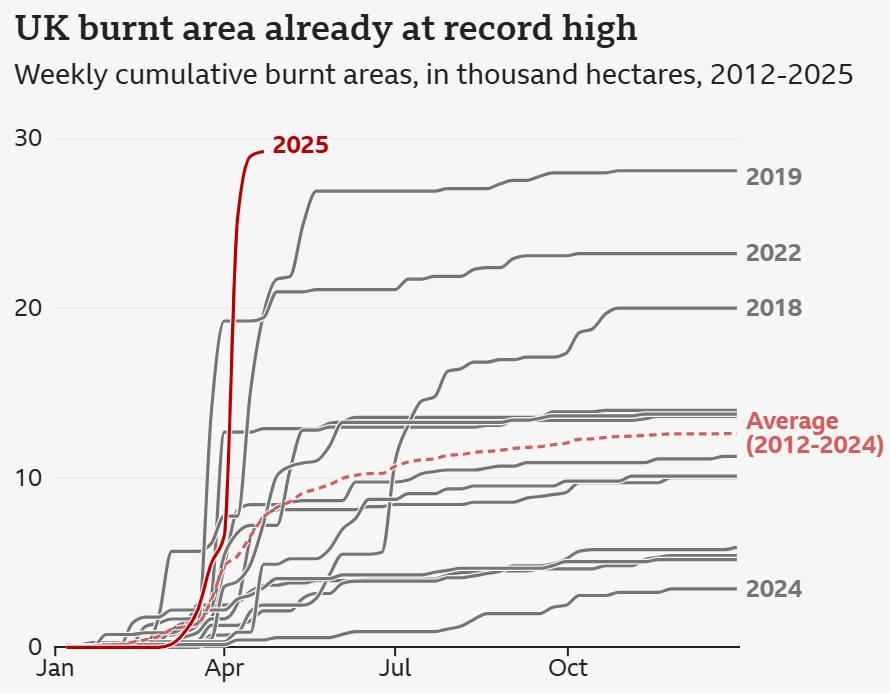While the fleet industry is often blamed for climate change, it’s also being affected by it.
Increasingly severe and unpredictable weather is putting occupational drivers and fleet operations at greater risk.
In this article, we break down emerging weather-related fleet risks and how managers can prepare.
Flooding and storms
With climate change comes rising sea levels. For coastal and low-laying areas of the UK, this means an elevated risk of flooding, particularly as coastal erosion intensifies and more barriers between the sea and infrastructure are lost.
Increasingly severe storms also contribute to the risk of flood, while posing a road-hazard in of themselves. In the event of a storm, flooding can occur anywhere lacking the preparedness, but areas near rivers are of course more susceptible to this type of emergency than others.
Floodwaters can quickly render roads impassable, strand vehicles, and damage both vehicles and cargo. Even shallow standing water can cause engine failure or compromise electrical systems, while fast-moving water presents a grave safety threat to drivers.
Storms also bring other hazards. High winds can overturn high-sided vehicles or blow debris onto roadways, while heavy rainfall reduces visibility and increases stopping distances.
These risks are only going to intensify. According to the UK Centre for Ecology and Hydrology, from July to December in 2023, the UK experienced record rainfall1, leading to roughly 700 flood warnings issued across England and Wales in January of 20242.
Furthermore, the latest annual Global Water Monitor report warns that flood and storm risks will become incrementally worse with each passing year, supporting the concern that the number of people affected by floods globally will double by 20303.
Transport and storage sector companies are by far the most impacted by flooding4 – yet only 3.4% of businesses in these sectors have climate change strategies in place5.
Fleet managers should develop contingency plans that include alternative routing, real-time weather monitoring, and protocols for suspending journeys when conditions deteriorate.
Investing in driver training for severe weather conditions is essential. Additionally, reviewing insurance coverage and ensuring vehicles are equipped with emergency kits can help mitigate the impact of flooding and storms on drivers and operations alike.
Rising temperatures
We’ve just experienced England’s hottest June since records began, so rising temperatures are top of mind as we enter the first phase of summer.
Current infrastructure in the UK transportation sector simply isn’t designed to withstand temperatures beyond those considered normal when developed. This insufficiency spans the roads themselves, vehicles, and of course drivers.
Roads
Depending on the material, UK road surfaces can start to soften between 30°C–50°C. While we won’t be seeing 50° days any time soon, even a sunny 20° day can generate temperatures of around 50°C on the ground as the dark road surface absorbs and builds up heat6.
Asphalts treated with polymer modified binders raise this softening point to 80°C – but it’s estimated that less than 5% of the UK’s road network features this enhanced surface6.
As surfaces become more pliable and sticky, they are much more prone to deformation under the weight of traffic. This can lead to rutting — permanent grooves in the wheel paths — and surface bleeding, where bitumen rises to the surface and creates a shiny, slippery film. Both of these issues compromise tyre grip and can significantly increase braking distances.
In prolonged heat, soft road surfaces can also be damaged by heavy vehicles, accelerating the formation of potholes and reducing the lifespan of the carriageway.
For fleet managers, this means that rising temperatures will not only increase the risk of incidents due to reduced surface friction but also contribute to more frequent road closures and repairs.
Proactive route planning, real-time condition monitoring, and driver training on how to adjust driving techniques in hot conditions will be critical tools in managing these risks.
Vehicles
The impact of heat stress on vehicles can be drastic, particularly for those exposed to extreme temperatures repeatedly over long periods, as is often the case with fleet vehicles.
From decreased fuel mileage to balding tires and compromised handling7, high temperatures create a range of mechanical challenges that can undermine safety and efficiency8. Heat accelerates the degradation of rubber components, increasing the likelihood of tyre blowouts — especially when tyres are under-inflated or worn.
Engine cooling systems are also put under additional strain as ambient temperatures rise, making overheating a more common risk. This can lead to sudden breakdowns if coolant levels are low or if radiators are not properly maintained.
Battery performance can suffer too; while cold weather is typically associated with battery failure, sustained heat shortens battery life by accelerating internal corrosion and fluid evaporation.
What’s more, air conditioning systems, essential not just for comfort but also for driver concentration and health, are more likely to fail during prolonged heatwaves.
Fleet managers should consider scheduling more frequent maintenance checks during summer months, paying particular attention to tyres, cooling systems, and air conditioning. Ensuring drivers know how to spot early signs of overheating and tyre wear can also help prevent costly vehicle failures and keep drivers safe in high temperatures.
Vehicle rotation can also help spread the impact of extreme heat more thinly across a fleet.
Drivers
Rising temperatures don’t just challenge infrastructure and vehicles, they also place significant strain on drivers themselves.
Fleet drivers spend extended periods behind the wheel, often in vehicles with large glass areas that can quickly become heat traps. Even with air conditioning, cab temperatures can climb to levels that impair concentration, slow reaction times, and increase the likelihood of fatigue-related incidents.
Heat stress and dehydration can cause headaches, dizziness, muscle cramps, and in severe cases, heat exhaustion or heat stroke. These health risks are particularly concerning for drivers undertaking long shifts or making multiple deliveries with frequent stops, which can mean repeated exposure to high temperatures when entering and exiting the vehicle.
Evidence shows that driver error increases in hot conditions, with studies linking high temperatures to reduced vigilance, higher aggression and slower decision-making. For professional drivers, even small lapses in concentration can have serious consequences for their safety and that of other road users.
There’s also the increased risk of dehydration and sunburn to account for, as well as reduced visibility when heat-derived visual distortions intensify over the road.
To help mitigate these risks, fleet managers should:
- Encourage drivers to stay hydrated by providing access to water and scheduling regular breaks in shaded or cooled areas.
- Ensure vehicle air conditioning systems are well maintained and functioning effectively.
- Consider adjusting shift patterns or delivery schedules to avoid driving during the hottest parts of the day wherever possible.
- Provide training so drivers can recognise early symptoms of heat stress and know when to stop and seek assistance.
- Ensure vehicles are equipped with sunshades, UV-protective window film, or other measures to reduce in-cab temperatures.
Wildfires
Historically and even currently, wildfires are rarely associated with the UK, but they’re becoming significantly more common as temperatures rise – and fleet managers need to take notice.
 Source: BBC
Source: BBC
UK motorways run through regions where we’re seeing the greatest uptick in wildfire risk9, and wildfire-related closures can be some of the most disruptive. For example, when the A3095 was closed during the Swinley Forest fire, traffic had to be rerouted for a week9.
Wildfires often develop and spread rapidly, leaving little time to react. Even when flames are not directly threatening infrastructure, smoke drifting across roads from the burn zone can create dangerous driving conditions by severely reducing visibility and causing respiratory irritation for drivers.
For fleet managers, these risks mean that wildfire preparedness is no longer an issue confined to Southern Europe, Australia or North America. UK fleets now need contingency plans that account for sudden route closures, diversions, and delays. This includes:
- Monitoring wildfire warnings and alerts in real time — particularly during prolonged dry spells.
- Establishing clear communication protocols so drivers can be informed quickly about changing conditions.
- Training drivers on how to respond if they encounter smoke or fire on their route, including when to stop, reroute, or evacuate.
- Reviewing insurance policies to ensure appropriate coverage for fire damage and business interruption.
Addressing gaps in current resources and tools
There is no shortage of tools and frameworks to help fleet managers assess and plan for climate risks – from internationally recognised standards like ISO 14090 and 14091, to UK-specific climate data through the Met Office UKCP18 platform.
However, a recent government review also revealed that there are substantial gaps in the current support landscape, impacting how the industry understands, applies, and shares this knowledge.
Many fleet operators and transport managers report feeling overwhelmed by the sheer volume of tools and guidance available. Even where resources exist, knowing where to start and how to interpret data can be a barrier to action. Building internal awareness, capability, and confidence remains a critical step for many organisations.
There are also persistent blind spots in understanding how different climate risks — beyond flooding — impact transport assets and operations, including the effects of heat, storms, wildfires, and their combined impacts. Although academic research is advancing quickly, industry knowledge varies significantly, and even organisations with mature risk management practices often still have areas of uncertainty.
Finally, climate risks rarely occur in isolation. Cascading impacts — where one disruption triggers failures elsewhere — are poorly understood across much of the transport sector.
These gaps mean that many fleet managers remain in reactive mode, responding to weather events as they happen rather than proactively building resilience and protecting drivers.
Healthy Working: Safe Driving – A practical first step
To start closing these gaps, it’s essential not only to plan for infrastructure and vehicle resilience but also to equip drivers with the awareness and skills to identify, avoid, and respond to climate-related risks on the road.
Cardinus Healthy Working: Safe Driving is our fleet risk management software, offering a practical, accessible way for organisations to begin this journey. This driver risk assessment and eLearning platform can help you:
- Raise driver awareness of weather-related hazards, from heat stress and storms to poor visibility and surface risks.
- Assess individual driver risk profiles and tailor training accordingly.
- Embed a culture of safety and proactive risk management across your fleet.
By combining strategic planning with targeted driver education, fleet managers can start bridging the gap between knowing climate risks exist and taking concrete steps to reduce them.
Get a free trial of Healthy Working: Safe Driving.
Final thoughts
Climate change is no longer a distant issue for the fleet industry. It’s an operational reality affecting roads, vehicles and driver safety today.
Building resilience starts with awareness and planning, but it also demands action. If you’re ready to learn more, download our free whitepaper on environmental issues in fleet management to explore practical steps you can take right now.
And if you’d like tailored support to assess driver risk, strengthen training, or plan your next steps, get in touch with the team at Cardinus. We’re here to help you make your fleet safer, healthier and more prepared for the road ahead.
References
- ENDS Report (2024). Rivers saw record flows in December ahead of widespread flooding. [online] Available at:https://www.endsreport.com/article/1856850/rivers-saw-record-flows-december-ahead-widespread-flooding [Accessed 3 Jul. 2025].
- ITV News (2024). Flooding impact will continue to be significant following rain. [online] Available at:https://www.itv.com/news/2024-01-05/flooding-impact-will-continue-to-be-significant-following-rain [Accessed 3 Jul. 2025].
- Carrington, D. (2020). Flooding to double worldwide by 2030, warn scientists. The Guardian. [online] Available at:https://www.theguardian.com/environment/2020/apr/23/flooding-double-number-people-worldwide-2030 [Accessed 3 Jul. 2025].
- Office for National Statistics (2024). Business insights and impact on the UK economy: 3 October 2024. [online] Available at:https://www.ons.gov.uk/businessindustryandtrade/business/businessservices/bulletins/businessinsightsandimpactontheukeconomy/3october2024 [Accessed 3 Jul. 2025].
- Business Money (2024). 2024’s severe weather has had major impact on UK transportation & storage companies. [online] Available at:https://www.business-money.com/announcements/2024s-severe-weather-has-had-major-impact-on-uk-transportation-storage-companies/ [Accessed 3 Jul. 2025].
- Road Surface Treatments Association (n.d.). Why are our roads melting? [online] Available at:https://www.rsta-uk.org/why-are-our-roads-melting [Accessed 3 Jul. 2025].
- UNEP FI (2024). Climate Risks in the Transportation Sector: A Sectoral Briefing. [online] United Nations Environment Programme Finance Initiative. Available at:https://www.unepfi.org/wordpress/wp-content/uploads/2024/05/Climate-Risks-in-the-Transportation-Sector.pdf [Accessed 3 Jul. 2025].


